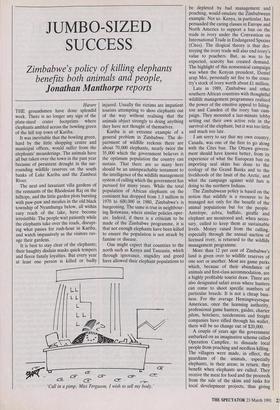JUMBO-SIZED SUCCESS
Zimbabwe's policy of killing elephants benefits both animals and people, Jonathan Manthorpe reports
Harare THE groundsmen have done splendid work. There is no longer any sign of the plate-sized crater footprints where elephants ambled across the bowling green of the hill top town of Kariba. It was inevitable that the bowling green, hard by the little shopping centre and municipal offices, would suffer from the elephants' meanderings. The animals have all but taken over the town in the past year because of persistent drought in the sur- rounding wildlife reserves on the south banks of Lake Kariba and the Zambezi River.
The neat and luxuriant villa gardens of the remnants of the Rhodesian Raj on the hilltops, and the little garden plots bursting with paw-paw and mealies in the old black township of Nyamhunga below, all within easy reach of the lake, have become irresistible. The people wait patiently while the elephants take over the roads, disrupt- ing what passes for rush-hour in Kariba, and watch impassively as the visitors rav- age their gardens. It is best to stay clear of the elephants; their haughty disdain masks quick tempers and fierce family loyalties. But every year at least one person is killed or badly injured. Usually the victims are impatient tourists attempting to shoo elephants out of the way without realising that the animals object strongly to doing anything they have not thought of themselves.
Kariba is an extreme example of a general problem in Zimbabwe. The de- partment of wildlife reckons there are about 70,000 elephants, nearly twice the 35,000 which the government believes is the optimum population the country can sustain. That there are so many here should be an unimpeachable testament to the intelligence of the wildlife management system of culling which the government has pursued for many years. While the total population of African elephants on the continent has dropped from 1.3 million in 1970 to 600,000 in 1980, Zimbabwe's is burgeoning. The same is true in neighbour- ing Botswana, where similar policies oper- ate. Indeed, if there is a criticism to be made of the Zimbabwe programme, it is that not enough elephants have been killed to ensure the population is not struck by famine or disease.
One might expect that countries to the north such as Kenya and Tanzania, which through ignorance, stupidity and greed have allowed their elephant populations to 'Call in a pimp, Miss Ferguson, I wish to sell my body.' be depleted by bad management and poaching, would emulate the Zimbabwean example. Not so. Kenya, in particular, has persuaded the caring classes in Europe and North America to support a ban on the trade in ivory under the Convention on International Trade in Endangered Species (Cites). The illogical theory is that des- troying the ivory trade will also end ivory's value to poachers. But, as was to be expected, scarcity has created demand.
The highlight of this nonsensical campaign was when the Kenyan president, Daniel arap Moi, personally set fire to the coun- try's stock of ivory worth about fl. million.
Late in 1989, Zimbabwe and other southern African countries with thoughtful wildlife management programmes realised the power of the emotive appeal to Isling- ton and Camden of the ivory ban cam- paign. They mounted a last-minute lobby setting out their own active role in the survival of the elephant, but it was too little and much too late.
I am sorry to say that my own country, Canada, was one of the first to go along with the Cites ban. The Ottawa govern- ment should have known better, from its experience of what the European ban on importing seal skins has done to the ecology of the Grand Banks and to the livelihoods of the Inuit of the Arctic, and what the campaign against wild furs is doing to the northern Indians.
The Zimbabwean policy is based on the notion that wildlife is a resource to be managed not only for the benefit of the animal populations but for the people. Antelope, zebra, buffalo, giraffe and elephant are monitored and, when neces- sary, culled to keep them at sustainable levels. Money raised from the culling, especially through the annual auction of licensed ivory, is returned to the wildlife management programme.
More than 12 per cent of Zimbabwe's land is given over to wildlife reserves of one sort or another. Most are game parks which, because of their abundance of animals and first-class accommodation, are a highly profitable tourist draw. There are also designated safari areas where hunters can come to shoot specific numbers of particular breeds. It is not a cheap busi- ness. For the average Hemingwayesque American, once the licensing authority, professional game hunters, guides, charter pilots, hoteliers, taxidermists and freight companies have rifled through his wallet, there will be no change out of $20,000.
A couple of years ago the government embarked on an imaginative scheme called Operation Campfire, to dissuade local people from poaching and needless killing. The villagers were made, in effect, the guardians of the animals, especially elephants, in their areas; in return, they benefit when elephants are culled. They receive the meat for food and the proceeds from the sale of the skins and tusks for local development projects, thus giving them an investment in sustaining wildlife populations. This admirable scheme, as with the entire wildlife management programme, is now under threat from the Cites ban. Revenues from the carefully administered and licensed ivory sales have dried up and a developing country like Zimbabwe can- not afford to finance an effective wildlife service from general revenue. The poaching of elephants is now on the increase. Wildlife rangers have been fight- ing what can only be described as a full-blown bush war against poachers for several years. The main action is against Zambian poachers who sneak over into the bush areas south of the Zambezi.
They come heavily armed, usually with the ubiquitous gun of Africa, the AK-47 assault rifle. But the Zimbabwean wildlife rangers contain men of special fighting experience, and they have in the past two years killed well over 100 poachers for the loss of only one ranger. The Zimbabwean government is a little sensitive about discussing or even admit- ting the special fighting abilities of their rangers. Many of them are former Selous Scouts, the unit set up by Ian Smith's rebel Rhodesian regime to operate as a forward reconnaissance and infiltration force among the liberation armies. At independence in 1980 the South African government wooed many of the scouts to its colonial adventures in Namibia and Angola. But some stayed and, with their skills in tracking and hiding in the bush, were recruited into the wildlife ser- vice. They have helped to make the calling of Zambian poacher a high-risk profession. The main target of the poachers has been and still is the increasingly rare black rhinoceros. Its horns are worth about £2,000 a kilogram on the black market, where they go to make dagger handles in the Middle East and, when powdered, aphrodisiac for jaded Chinese and Japanese. But since the Cites ban the Zambian poachers have also started taking elephants. Fifty-five were killed last year, compared with less than a handful the year before, as the illicit price of ivory exceeded the £50 a kilogram it had reached on the open market before the ban. The Cites ban comes up for review in 1992. This time the countries of southern Africa intend to make their case vigorous- ly, in advance of the campaign for a continued ban in the ivory trade. Bots- wana, Zambia, Malawi, Namibia and Zim- babwe have said they intend to defy the international ban on the trade in ivory. They will continue culling their over- population of elephants. They intend to continue holding sales of registered ivory and to keep returning money from these sales to wildlife management. They intend to keep killing poachers. Bully for them.
Jonathan Manthorpe is Africa correspon- dent of Southam News of Canada.



























































 Previous page
Previous page